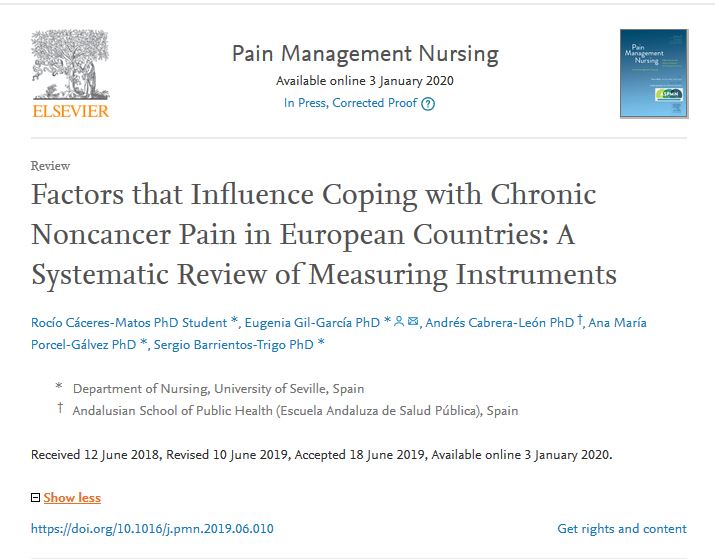
Background and aim
Coping can be defined as the cognitive efforts and behavioral practices that people develop in situations which they consider to be stressful. In people with Chronic Non-Cancer Pain (CNCP), coping is influenced by the biological, psychological, and socio-cultural resources available to them. The aim of this systematic review is to evaluate the psychometric properties of European measuring instruments related to coping with CNCP in non-hospitalized adults.
Database and data treatment
The review was conducted following the guidelines of the PRISMA Statement and the methodological framework of the Joanna Briggs Institute. The CINAHL, PubMed, Scopus, and Web of Science databases were searched by two reviewers independently. The analysis of psychometric properties was performed using the COnsensus-based Standards for the selection of health Measurement INstruments (COSMIN) checklist, and the risk of bias was analyzed using the Quality Assessment of Diagnostic Accuracy Study-2 (QUADAS-2) tool.
Results
Thirty-six studies validated twenty-four different instruments. The Portuguese version of the Pain Beliefs and Perceptions Inventory (PBPI), which assess catastrophizing, and the Spanish version of the Roland-Morris Questionnaire (RMQ), which assess disability, are the instruments with the best methodological quality and bias control.
Conclusions
There are important gaps in the measurement of different aspects of pain coping, such as stress, social and family support, or self-care. Future studies could consider the creation of an instrument to comprehensively assess the resources that influence coping with chronic non-cancer pain.
Chronic pain is characterized as a personal, sensory, and emotional experience, composed of biological, psychological, and sociocultural processes of more than 3 months’ duration (International Association for the Study of Pain, 1986). When chronic pain is not associated with an oncologic condition, it is referred to as chronic noncancer pain, or CNCP (Cunha, Pinto-Fiamengui, Sampaio, & Conti, 2016). Chronic pain is a health condition affecting 1.5 billion people worldwide (Global Industry Analysts, 2011). The estimated prevalence of chronic pain in Europe is 19% of the population (Bushnell, Čeko, & Low, 2013). Spain has the lowest prevalence of CNCP, at 17% (Cabrera-León et al., 2017). The cost of chronic pain in Europe exceeds €300 trillion, about 1.5%-3% of the gross domestic product of the European Union countries (Torralba, Miquel, & Darba, 2014).
Individuals with CNCP generate adaptive and coping responses different from those of individuals with neurodegenerative diseases or oncologic conditions. In these cases, coping is determined by expectations for prognosis, aggressiveness of treatment, and level of dependence (Ferrer-Peña, Gil-Martinez, & Pardo-Montero, 2016).
Coping is defined as the cognitive and behavioral efforts that individuals make in situations they consider to be stressful (Lazarus & Folkman, 1984). Because of its complexity and subjectivity, coping requires an integrative understanding of the resources influencing it (Carvajal et al., 2011, Ferrer-Peña et al., 2016). Coping is influenced by biological, psychological, and sociocultural resources that individuals learn and develop throughout their lives. Research shows that different resources can hinder and/or improve coping. High levels of pain intensity, disability (Ferrer-Peña et al., 2016), stress (Catalano, Chan, Wilson, Chiu, & Muller, 2011), anxiety/depression (Bushnell et al., 2013), and pain catastrophizing (Tsang et al., 2008) act as resources that hinder adaptation to pain. In contrast, resilience (Catalano et al., 2011), self-esteem (Hegarty & Wall, 2014), high levels of perceived quality of life (Von Korff, 2011), and social support act as resources that favor coping with CNCP (Cabrera-León et al., 2017, De Sola et al., 2016, Norrefalk, 2011).
Because of the high prevalence of chronic pain, the limitations that chronic pain creates for people who suffer from it, and the high health care costs it causes (Registered Nurses’ Association of Ontario, 2013), many authors and organizations call for a change of perspective and approach (Breivik et al., 2013, Wranker et al., 2014). Thus the Pain Proposal initiative, endorsed by the European Pain Federation (EFIC), proposed that the assessment be carried out in a comprehensive manner (Torralba et al., 2014). A few years later, the Registered Nurses’ Association of Ontario stressed the importance for health care professionals to be aware of the tools available to assess resources that influence coping (Registered Nurses’ Association of Ontario, 2013).
For all these reasons, the two principal aims of this systematic review were to (a) identify instruments, developed and tested in Europe, that measure coping with CNCP; and (b) assess the reported psychometric properties of the instruments identified.
The literature search attempted to answer the following two research questions: (a) What are the instruments, developed and tested in Europe, that measure coping with CNCP in nonhospitalized adults? (b) What are the quality criteria of the instruments assessed on the basis of their psychometric properties?


